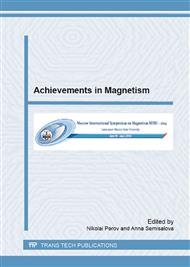p.12
p.16
p.20
p.25
p.30
p.34
p.38
p.43
p.47
The Investigation of Critical Properties of the Transition from Modulated Phase into Paramagnetic Phase
Abstract:
The anisotropic Ising model with competing interactions in the region of transition from a modulated phase into paramagnetic state is investigated by the Monte-Carlo methods. By means of histogram analysis and the finite-size scaling method, the modulated – paramagnetic phase transition is shown to be a second order phase transition. Critical parameters and temperatures of phase transitions in this region are calculated.
Info:
Periodical:
Pages:
30-33
Citation:
Online since:
July 2015
Authors:
Price:
Сopyright:
© 2015 Trans Tech Publications Ltd. All Rights Reserved
Share:
Citation:


